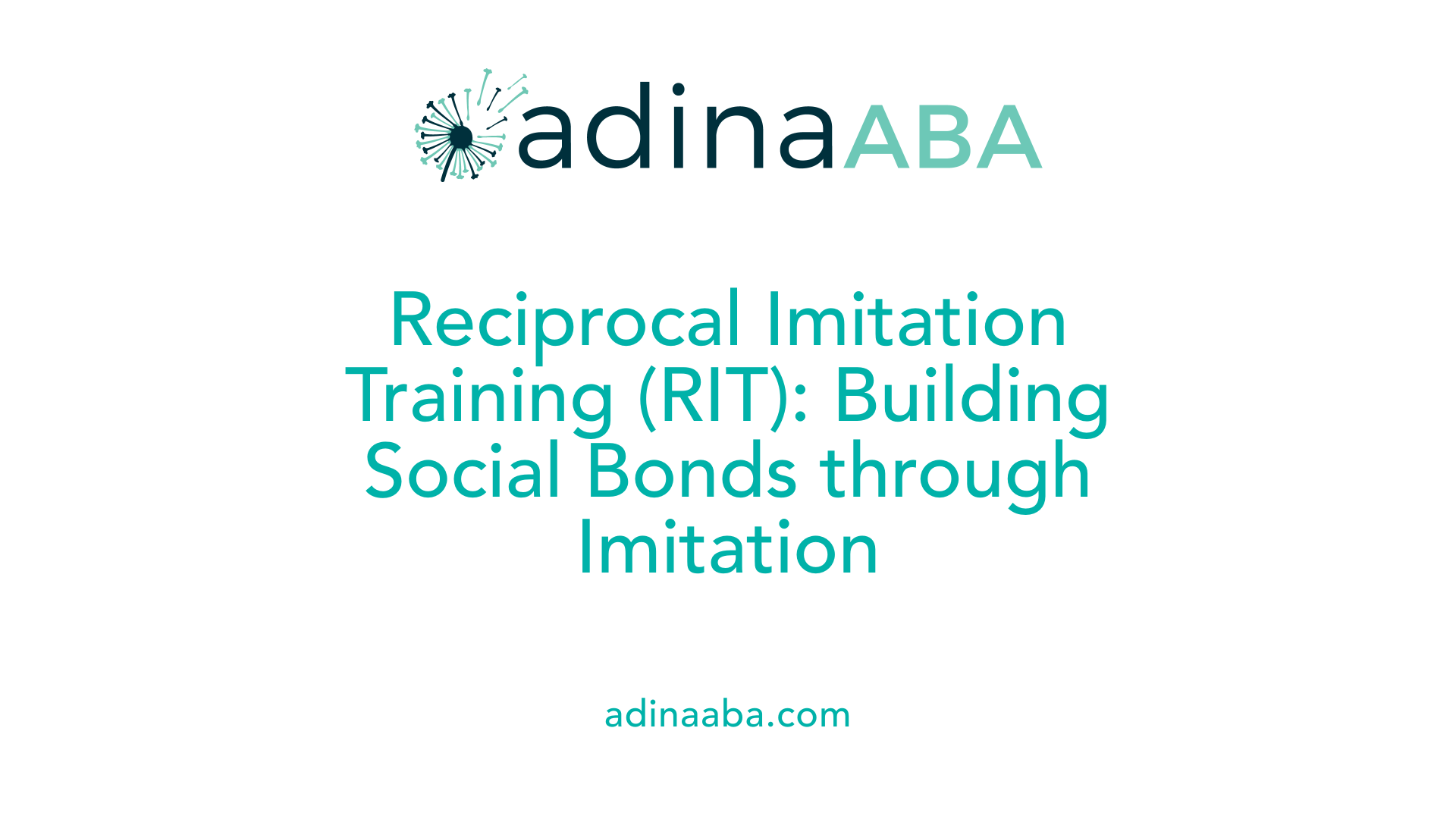Using ABA to teach imitation skills

Understanding the Foundations of Imitation in Autism
Imitation is a cornerstone skill in early childhood development, essential for social interaction, language acquisition, and cognitive growth. For children with autism spectrum disorder (ASD), difficulties in imitation can impede these critical developmental areas. Applied Behavior Analysis (ABA) offers effective, systematic approaches to teach imitation skills, thereby fostering communication, social reciprocity, and independence. This article explores how ABA utilizes various techniques, including Naturalistic Developmental Behavior Interventions such as Reciprocal Imitation Training (RIT), to promote imitation and related social skills.
The Importance of Imitation for Social Reciprocity and Communication

Why are imitation skills important for social reciprocity and communication development?
Imitation is a fundamental ability that greatly influences a child's social and language growth. When children imitate others, they learn to understand social cues, mimic gestures, facial expressions, sounds, and actions, which are crucial for meaningful interactions. This copying process helps children develop joint attention—the shared focus on objects or activities—which is a key element of social understanding.
For children with autism spectrum disorder (ASD), challenges with imitation can limit their ability to engage socially and communicate effectively. Difficulties in imitating social gestures and behaviors can delay the acquisition of language and impair emotional exchanges, affecting overall social reciprocity.
Teaching imitation through structured interventions, such as Reciprocal Imitation Training (RIT) or Applied Behavior Analysis (ABA), can foster spontaneous and generalized imitation skills. Improvements in imitation serve as a foundation for broader social behaviors, including turn-taking, sharing interests, and responding to social engagement.
Enhancing imitation skills not only supports language development but also boosts social interaction and emotional understanding. When children learn to imitate, they are better equipped to participate in reciprocal exchanges, which are vital for forming relationships and navigating social environments. Overall, imitation forms the stepping stone toward more complex social and communicative skills, which are essential for children with autism to connect meaningfully with others.
Techniques and Strategies Used in ABA to Teach Imitation

How does ABA therapy teach imitation skills to children with autism?
ABA therapy employs a range of structured methods to develop imitation skills in children with autism. Key strategies include prompting, modeling, reinforcement, and gradual prompt fading, which work together to help children copy behaviors. Therapists often use discrete trial teaching (DTT), which involves broken-down, step-by-step instructions aimed at specific imitation targets.
Contingent imitation is another vital method, where therapists imitate the child's actions to motivate spontaneous imitation. The process begins with simple movements, such as grasping a toy or clapping, then progressively moves to more complex behaviors like using objects or vocalizing.
Prompts—such as physical guidance, visual cues, or verbal hints—are initially provided to assist learning. Over time, these prompts are systematically reduced, encouraging independent imitation. Therapists focus on making the activities engaging and fun, using preferred toys or interactive tools like mirrors and social robots, to sustain motivation.
Interventions are tailored to each child's abilities and needs, emphasizing positive reinforcement. When a child successfully imitates a behavior, they receive praise or a reward, strengthening their motivation for further skill development.
Overall, ABA emphasizes gradual learning, consistency, and individualization, ensuring that imitation skills translate into spontaneous social and communicative behaviors across various settings and contexts.
The Role of Reciprocal Imitation Training (RIT) in ABA Therapy

What is the role of Reciprocal Imitation Training (RIT) in ABA therapy?
Reciprocal Imitation Training (RIT) is a specialized approach within Applied Behavior Analysis (ABA) therapy. It serves as an effective, naturalistic intervention designed to teach young children with autism to imitate spontaneously during social interactions. Unlike traditional, highly structured methods, RIT focuses on embedding imitation within playful, everyday routines, making learning more engaging and functional.
The fundamental goal of RIT is to help children develop core social-communication skills, including gestural imitation, object imitation, joint attention, and shared engagement with others. It emphasizes reciprocal, back-and-forth interactions where the child is encouraged to imitate what the adult or therapist does. This mutual imitation process enhances the child's motivation to participate in social exchanges, fostering a foundation for language development and social skills.
Strategies involved in RIT, such as contingent imitation
Implementing RIT involves several strategic methods. A key technique is contingent imitation, where the therapist or parent imitates the child's actions or sounds immediately and responsively. This modeling demonstrates social reciprocity, showing the child that their behaviors are noticed and valued.
Other strategies include:
- Modeling play behaviors with toys or objects to expand imitation opportunities.
- Being face-to-face at the child's eye level to promote engagement.
- Using animated and expressive language, with simplified and repetitive phrasing to support understanding.
- Following the child's lead to ensure the interaction feels natural.
- Reinforcing spontaneous imitation with praise and encouragement.
These methods collectively help the child learn to imitate not only specific behaviors but also to generalize imitation to new contexts and routines.
How RIT promotes spontaneous imitation and social engagement
A central aim of RIT is to encourage children to imitate behaviors on their own, outside of direct prompts. By frequently pairing actions with positive reinforcement and modeling in fun, social contexts, children gradually start to imitate spontaneously.
This spontaneous imitation is crucial because it reflects genuine social motivation and understanding. As children become more comfortable with reciprocal interactions, they show increased social responsiveness, better joint attention, and improved communication, including gestures and early words.
Moreover, RIT’s emphasis on naturalistic play during daily routines—such as dressing, eating, or bathing—helps these skills transfer into real-world situations, supporting functional social participation.
Research evidence supporting RIT effectiveness
Multiple peer-reviewed studies substantiate the positive impact of RIT. Research by Ingersoll and colleagues illustrates significant improvements in imitation skills among children with autism following RIT interventions. These studies also report enhancements in related social behaviors, such as joint attention, gesture use, and language development.
Furthermore, RIT’s naturalistic approach facilitates easier generalization of skills across various settings and caregivers, which is often a challenge in autism interventions.
In summary, RIT plays a vital role in ABA therapy by offering a child-centered, engaging method to develop spontaneous imitation and social skills. Its evidence-based strategies demonstrate meaningful progress in helping children with autism build essential communication and social engagement capabilities within their everyday lives.
Phases and Methods Involved in Imitation Training within ABA

What are the phases involved in imitation training within ABA?
Imitation training within Applied Behavior Analysis (ABA) involves a systematic process aimed at teaching children with autism to replicate behaviors, gestures, and sounds. The initial step is to conduct a thorough assessment of the child's current abilities to identify simple and achievable target behaviors. This helps tailor the intervention to individual needs.
The next phase includes clearly modeling the desired actions or sounds. Therapists often use exaggerated and visible demonstrations to make imitation easier to understand. Following modeling, prompts are introduced to guide the child to imitate. These prompts typically progress from more explicit cues to less intrusive supports, following a systematic hierarchy.
As children begin to imitate more accurately, positive reinforcement—such as praise or access to preferred activities—is immediately provided to strengthen the behavior. Throughout these phases, error correction strategies are implemented to support accurate learning and prevent frustration.
Monitoring progress regularly is vital. Data collection happens after each session to evaluate mastery and determine when to move to more complex skills or to shift focus toward generalization. The final phase involves testing for skill transfer outside the therapy environment, ensuring that imitation skills are maintained across different settings and stimuli without immediate reinforcement.
Research Evidence Supporting Imitation Training in ABA
What research supports the effectiveness of imitation training in ABA?
A substantial body of peer-reviewed research demonstrates that imitation training is highly effective in ABA therapy for children with autism spectrum disorder. One of the earliest influential studies by Kaufman et al. (1976) showed that incorporating contingent imitation into structured teaching methods, such as discrete trial training (DTT), significantly improved children’s ability to imitate and enhanced their social interaction skills.
More recent studies highlight the success of Reciprocal Imitation Training (RIT), an evidence-based naturalistic intervention that emphasizes spontaneous imitation within play. Research by Ingersoll and colleagues has shown that RIT not only increases imitation skills but also boosts expressive language, joint attention, and pretend play, which are critical for overall social communication development.
Furthermore, combining contingent imitation with other ABA strategies like DTT has been found to support children in acquiring more complex imitation behaviors, especially when paired with motivation and reinforcement. These studies indicate that targeted imitation training results in meaningful improvements in core social and communication skills, which tend to be maintained over time with continued practice and naturalistic reinforcement.
Overall, the evidence confirms that imitation training, especially within naturalistic contexts, is an effective component of ABA that can foster long-term developmental gains in children with autism.
Foundational Principles and Concepts of Imitation Training in ABA
 Imitation training in Applied Behavior Analysis (ABA) is built upon fundamental principles that enable children with autism spectrum disorder (ASD) to learn and replicate behaviors effectively. Central to these principles are reinforcement, prompting, modeling, and generalization.
Imitation training in Applied Behavior Analysis (ABA) is built upon fundamental principles that enable children with autism spectrum disorder (ASD) to learn and replicate behaviors effectively. Central to these principles are reinforcement, prompting, modeling, and generalization.
Reinforcement involves providing positive feedback, such as praise or rewards, immediately after a correct imitation, which encourages the child to repeat the behavior in the future. Prompting is used to guide children to imitate, starting with physical or visual cues and gradually fading these prompts to foster independence.
Modeling plays a crucial role; therapists or parents demonstrate behaviors, gestures, or vocalizations for the child to imitate. This can include simple actions like clapping or more complex tasks such as using utensils or engaging in social greetings.
Generalization ensures that children can transfer their imitation skills across various settings, people, and materials. For example, a child who learns to imitate hand-flapping during therapy should later be able to imitate similar gestures during play at home.
The structured approach in imitation training often involves clear, step-by-step procedures. Initially, the child observes a model performing a behavior, then attempts to imitate with support. Upon successful imitation, the behavior is reinforced. Over time, prompts are systematically faded, and the child is encouraged to independently imitate behaviors across different contexts.
In addition to structured interventions, naturalistic approaches like Reciprocal Imitation Training (RIT) incorporate spontaneous imitation within play, fostering social responsiveness and communication.
Effective imitation training also includes individualization, tailoring strategies to each child's needs, preferences, and developmental level. This personalized approach maximizes motivation and promotes consistent skill acquisition.
By combining these principles—reinforcement, prompting, modeling, and generalization—teachers and therapists can help children develop foundational social and communicative skills that serve as a basis for further learning and interaction.
Building a Foundation for Lifelong Skills
Incorporating imitation training within ABA not only enhances immediate social and communication skills but also lays the groundwork for lifelong learning and social engagement. Techniques such as RIT and systematic prompting are supported by extensive research, demonstrating their effectiveness in fostering spontaneous and generalized imitation. As children develop these skills, they gain greater independence, improve their ability to participate in social interactions, and build a foundation for more complex behaviors. Engaging parents and caregivers in naturalistic and play-based strategies further amplifies these benefits, ensuring that imitation skills translate into meaningful everyday experiences. Ultimately, understanding and applying evidence-based imitation interventions are vital steps toward supporting children with autism in reaching their full social and developmental potential.
References
- Reciprocal Imitation Training - McRory Pediatric Services
- Understanding Imitation in ABA Therapy
- A Look at Examples of Imitation in ABA
- 12 Ways to Teach Imitation to Children With Autism | Strides ABA
- Imitation in ABA: Examples, Techniques, and Benefits
- Teaching imitation to children with autism: A focus on social ...
- Let's Learn ABA: Imitation - Beyond the Label
- Reciprocal Imitation Training | Mumsnet
More Resources
Expert Clinicians
Get started today ->




.jpg)
.jpg)
